The hybrid hens begin to lay at about 20 weeks and if they do this mid to late summer, should lay through the winter but have a short life of about 2-3 years. Pure breeds tend to lay in the spring and summer, having a rest in the winter, but live for more years.
If using a breeder ration, when egg laying commences under natural lighting conditions in the Spring, fertile eggs may be expected within 10 days of the male being introduced. If the male is already running with females it is possible that their eggs will be fertile from the first laying. If a different breed cock bird is running with females, allow a fortnight for the correct bird to be fertile with those hens after removal of the other cock bird. An average breeding ratio is one male to four females. It is not necessary for the male to copulate with each female daily. He can fertilise several eggs at one time if there is free access for the sperm to travel to the ovary but hens will lay without a cock bird being present. Some of the more fluffy breeds may need feathers removing from around their vent in order for successful mating to take place due to the fact that the birds do not have external genitalia and merely touch vent to vent when mating in order to transfer the semen. Cocks will have favourite hens and the feathers on the backs of these hens will be worn away. In order to prevent this if you want to show your birds, put the cock in with the hens for only a few minutes every other day. The flexible pin bones either side of the vent will be easily felt if the hen is not too fat and three finger-widths apart if a large breed hen is laying.
Egg Production
Only the left ovary is functional. If damaged, the vestigial right one can function but usually as a testis, so intersex occurs: a bird is genetically female with male plumage and crows. Once this happens she will not lay again.
The function of the ovary is influenced by light levels.
Yolk is produced in the liver and travels in the bloodstream to the ovary.

Fig 1: The egg
Timing of egg production
The oviduct is extruded through the vent (cloaca) so egg and faeces do not mix, dirty eggs get so from dirty feet. A hen misses a day if ovulation (30 minutes after laying) occurs in the dark. The definition of a clutch is the number of eggs until this missed day.

Fig 2: The left Ovary and Oviduct of a chicken
Incubation
For the small poultry keeper there is a choice of two methods of hatching chicks - natural or artificial. It is best to gain experience and confidence in both. Hen eggs take 21 days to hatch. Some very small bantam eggs may hatch a day early and really large poultry such as Cochins may be a day later. Adult birds should be fed a breeder ration for 4-6 weeks before the eggs are to be set (incubated) to increase both fertility and hatchability. Only good sized, normal shaped eggs should be set. In the absence of a cockerel, fertile eggs will have to be bought in. A fertile egg remains dormant until it is placed in the correct temperature to develop.
Incubation times:
- Chickens 21 days
- Pheasants 24-28 days
- Turkeys and ducks 28 days
- Geese 30+ days
- Guinea fowl 28 days
- Quail 17 days
A broody hen has the instinct to sit upon eggs, keeping them warm and incubating them until they hatch. Hybrids have been selected so that broodiness is reduced but they can still sometimes go broody. One hen will insist on staying most of the time in the nestbox and may well try and peck when eggs are being collected. To check if she is really broody, a hand should be gently slid under her, palm up, and if she "cuddles" the hand with her wings, then she is serious. The best way to reset the cycle is to construct a "sin bin". This could be as simple as a dog crate with a small-mesh floor and put in a light, airy but weather-proof area with food and water. It takes about a fortnight for this to be effective and the broody bird should not be let out before this time since she will go straight back to the nestbox and begin sitting again. After 2 weeks in the sin bin, the bird should be carefully integrated back into the flock (or place the sin bin in the henhouse if there is space); she should then begin to lay properly again after that quite quickly. The next time she looks broody she should be put in the sin bin straight away for a few days, which may be successful as the hormonal effects are not so profound at the beginning of the broody cycle.
Natural hatching
Natural hatching under a broody hen is the ideal way to raise a few chicks and children love the experience. It is, however, essentially dependent on having a broody or broodies at the same time as the eggs needing to be set.
When dayolds are bought in they need to drink and their beaks should be dipped in tepid water before being placed in a smallish cardboard box for warmth and put within sound of a hen for about an hour. The chicks should be concealed in the palm of a hand and placed gently under her, removing the eggs at the same time. This is best done in the dark, but it depends on what time of day the chicks are obtained. More chicks may be added within the next 24 hours only; the bird cannot count but she has colour vision and can tell the difference between chicks, attacking new ones after the 24 hour window of integration.
Artificial hatching
This involves the use of an incubator to hatch eggs. Small incubators are in regular use with many poultry keepers, the advantage being that incubation conditions are instantly available at the flick of a switch. It saves the extra space of pens for broodies and takes very little electricity to run. Technical improvements have greatly increased efficiency, but best results will be obtained with eggs that are between 24 hours and seven days old and which have been stored in a cool (10°C, 50°F) place and turned daily. Incubators or hatchers require to be cleaned between hatches. Only recommended disinfectants should be used, because bleach-based ones, such as Milton, can damage the metal in an incubator. It is best to use Virkon, F10 or egg sanitisers. If eggs are to be set eggs on a weekly basis, then a separate hatcher is the only sensible solution as the huge amount of bacteria and dust released on hatching is likely to infect the other eggs still incubating.
The yolk is the main source of nutrition for the embryo, the final amount (yolk sac) is absorbed just before hatching. Yolk is composed of protein and fat and the colour is affected by carotenoid pigments in the diet, whether from grass or artificial pigments. The albumen is composed of protein.
During incubation it is sensible to candle the eggs. This involves holding a small bright torch to the broad end of the egg in a dark room in order to see inside.
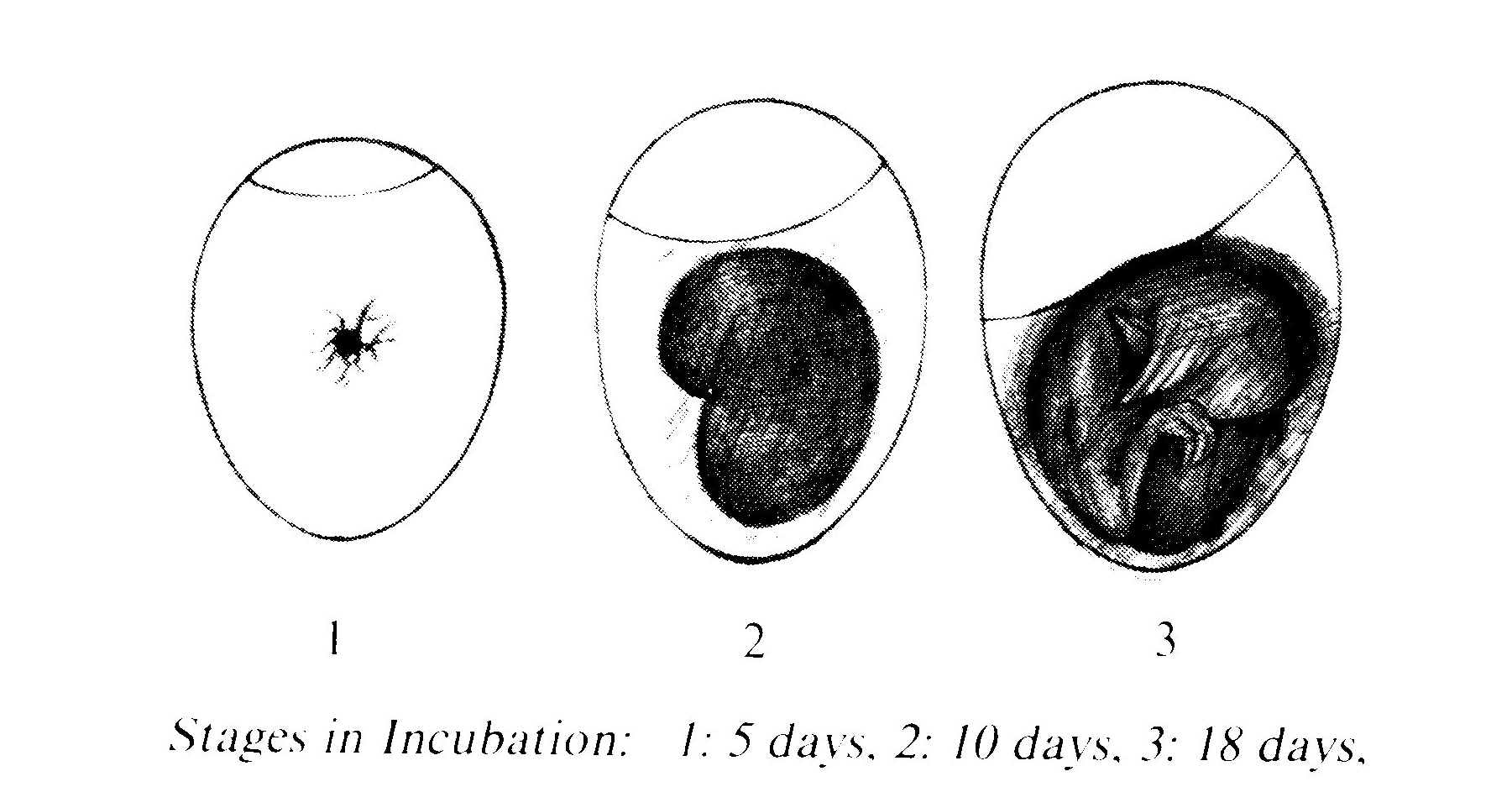
Fig 3: Candling stages of incubation
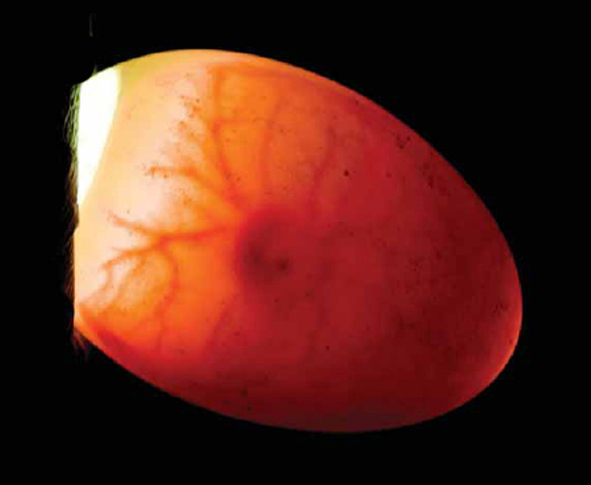
Fig 4: Healthy embryo, about 7 days
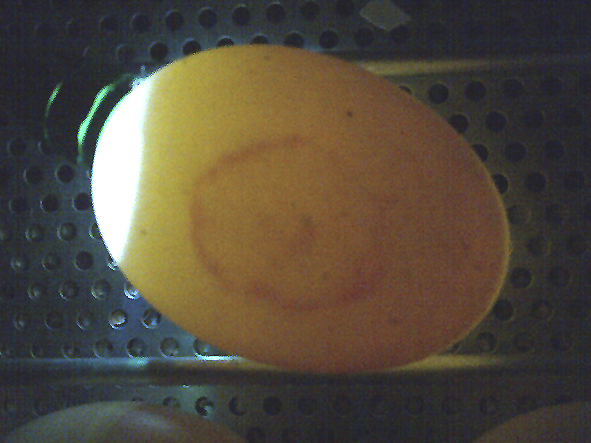
Fig 5: Dead embryo, sat on by broody, then got too cold
Problems associated with breeding/egg production
Oviduct infections
Infections affect egg production, fertility and hatchability. The causal agent is often E. coli: post mortem of dead-in-shell (unhatched fertile eggs) will define this.
Poor hatchability
This can be due to inadequate or incorrect nutrition for instance if a layer and not a breeder ration has been fed. Infectious Bronchitis (IB) or other infection, poor egg storage, poor incubation technique will also affect hatchability. Post mortem examination and culture is again useful.
Infertility
Infertility can be due to lack of sperm, lack of viable sperm, lack of energy or physical access being denied. Causes include inbreeding, stress or certain antibiotics. Some breeds have such fluffy feathers that the cocks cannot physically reach the hens and both sexes need feathers removed around the vents. Vent feathers clogged up with faeces or lice eggs will prevent access by the cockerel. Heavy flea infestations may depress the cockerel and any concurrent disease can make him infertile. If there is more than one cockerel they may be jealous of each other and push each other off the hens.
Vent gleet
This is caused by a venereal herpesvirus, which settles in the nervous system. The vent is inflamed and has a necrotic, yellow, moist covering. Once smelt, the pungency of vent gleet is never forgotten. The condition is not common, but it is untreatable and contagious, so affected birds are usually culled.
Prolapsed oviduct
Distressingly, the only presenting sign may be a dead hen with her back end pecked out as hens are obsessively attracted to red and thus become cannibals. Stress, age, obesity and poor nutrition will all contribute to the condition. There is no cure and the best laying birds are more prone.
Preferential mating
A bare neck, torn back and loss of feathers denote a favourite female. The cockerel should be separated, any fresh wounds treated and the hen left to heal in peace. Saddles may be fitted on large breeds such as Orpingtons.
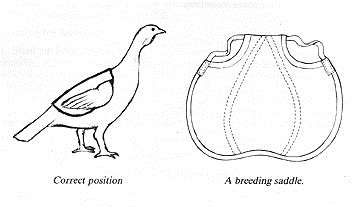
Fig 6: Breeding Saddle for Hens or Turkeys
Egg eating
This is a vice, caused originally by poor design nestboxes, boredom, poor nutrition, a soft-shelled egg laid on the floor or a broken egg. It takes very little time for the vice to spread throughout the flock as eggs are, after all, an excellent source of nutrition. If noticed early on by perhaps a drop in expected egg numbers, small bits of shell on the ground or egg on the face of the culprit, the old fashioned cure was to fill an egg with a strong curry and mustard mix. This was subsequently found to be useless as hens do not have capsaisin receptors! Effective remedies are to scatter 10-15 table tennis or golf balls or pottery eggs in the hut, make the nestboxes darker and ensure eggs are collected several times a day.
Egg peritonitis
This is sometimes known as internal laying because the yolk misses the funnel of the infundibulum and descends into the abdominal cavity, particularly if the bird has been stressed at ovulation. It can be caused by a previous IB infection (see Respiratory Diseases other than Mycoplasma Bulletin). One yolk will be scavenged by the body defences, but several yolks may descend together or infection sets in and the resulting peritonitis can quickly become fatal. The bird will be lethargic and depressed. If caught in the early stages, antibiotics may help but this condition is most often found at post mortem.
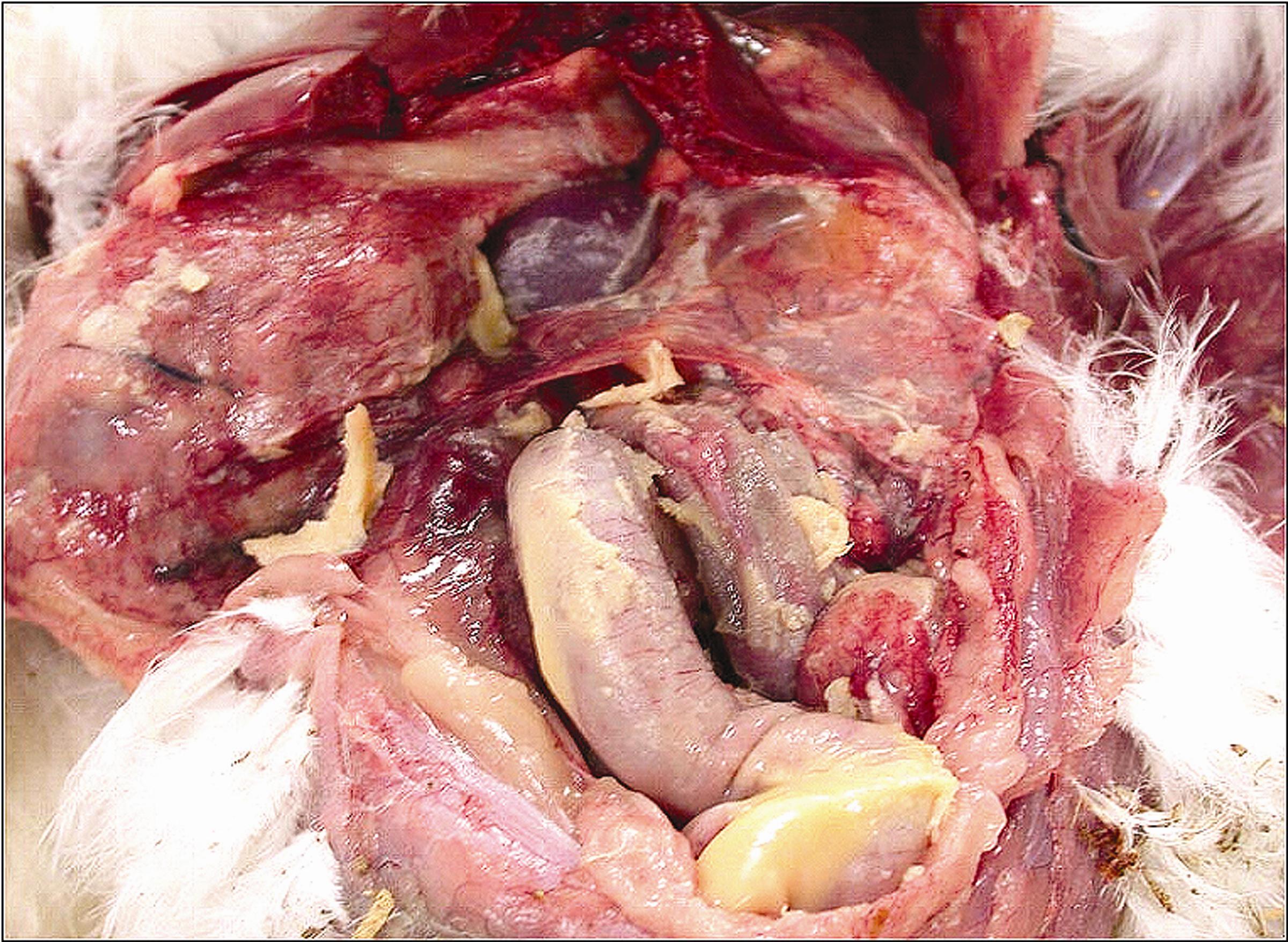
Fig 7: Egg Peritonitis at post mortem
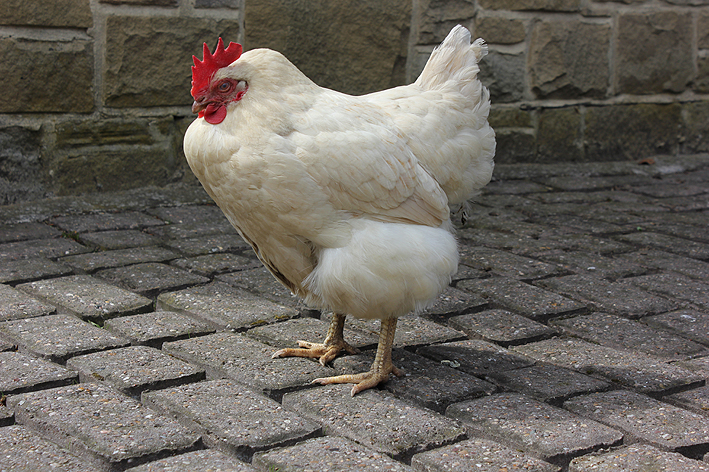
Fig 8: Typical stance of hen with egg peritonitis
Double yolks
Double yolks are only a problem if the eggs are kept for hatching; no double yolker has been known to hatch and survive. Double yolkers usually occur in older hens.
Downgraded eggs
Occasionally meat or blood spots appear in eggs. These are harmless, but if eggs are sold they will be downgraded as it is an aesthetic problem. Hens which consistently lay eggs with slab-sided or wrinkled shells are likely to be carriers of IB (see Respiratory bulletin) and should be culled. Stress can result in the occasional odd-shaped egg, especially those with an equatorial bulge, which results from rough handling of the bird. Hens which consistently lay thin, porous or soft-shelled eggs may be suffering from a calcium imbalance, poor nutrition, IB, excessive temperature or antimicrobials. At the beginning and end of lay, odd-shaped eggs may appear. Loss of shell colour can indicate IB, although the very dark brown eggs will tend to fade as the hens reach the end of lay. Small eggs indicate either pullets just coming into lay or inadequate water or IB and this is also indicated if the chalazae are ruptured.
Egg bound
Hens become egg bound usually due to a calcium imbalance which may be dietary or brought on by stress such as exhibiting. The bird needs to be kept warm and a little warm olive oil put into the vent. If the egg is partially out of the vent but still within the oviduct, it may be necessary to implode the egg by extracting the contents without breaking the shell, but trauma from the shell may cause future egg laying problems. Calcium supplements will only be helpful if they are in a soluble and absorbable state. The Birdcare Company manufactures one called Calcivet, but it should only be used occasionally because repeated use causes the calcium regulatory mechanism to become lazy.
Diseases passed to the chick through the egg:
Viruses: reoviruses - viral arthritis
retroviruses - lymphoid leucosis
Bacteria: salmonella, E. coli, staphylocci, mycoplasmas
Fungus: aspergillus





